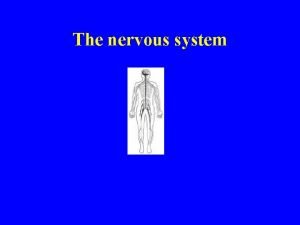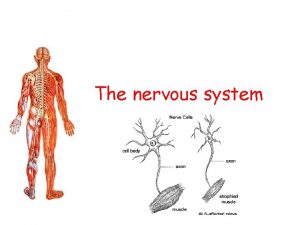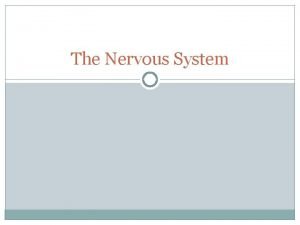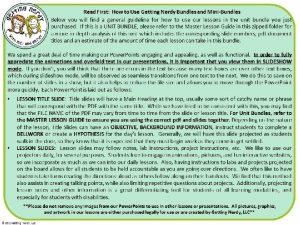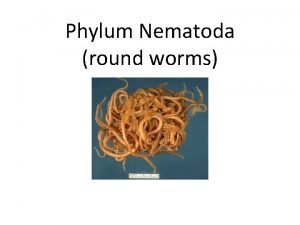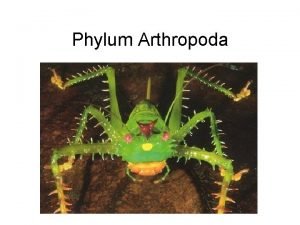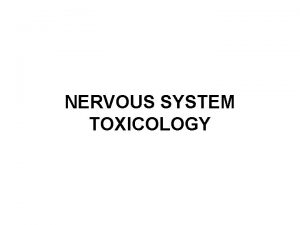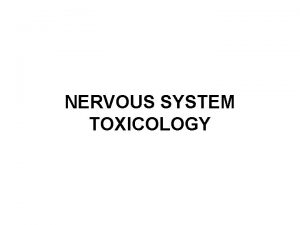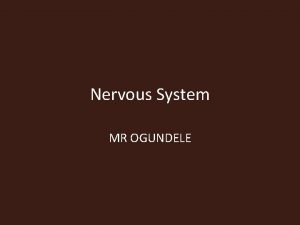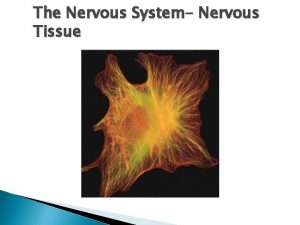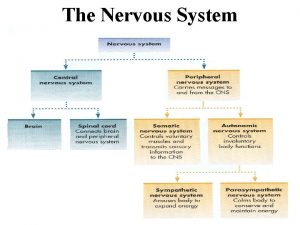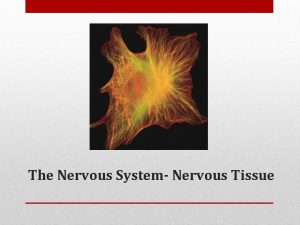The Nervous System The Nervous System 1 Two























- Slides: 23

The Nervous System

The Nervous System • 1. Two main divisions • a. Central Nervous System (CNS) – consists of brain and spinal cord • b. Peripheral Nervous System (PNS) – includes nerves extending from brain and spinal cord • c. The CNS receives messages from the PNS, interprets them, and then sends out a response.

Neurons • 2. Neurons - nerve cells that transmit messages to and from the spinal cord and brain • a. Sensory Neurons – carry messages FROM body TO CNS • ex. Playing games in computer lab. When light switches to green, a sensory neuron transmits a message from your eye to your brain

Neurons • b. Motor Neurons – carry message TO body FROM CNS • ex. Your brain sends a signal through a motor neuron to tell your finger to click the mouse. • c. Interneurons – connect neurons

3. Structure and Functions of Neurons • 1. Dendrites – receive information and transmit impulses toward cell body • 2. Cell Body – large area which contains cell nucleus or power plant • 3. Axon – transmit impulses away from cell body and toward axon terminal • 4. Axon Terminals – branched structures at the ends of neurons. • 6. Myelin Sheath – insulating coat which covers the axon. This helps messages relay faster.

Neuron

The Central Nervous System • 1. The brain • a. Helps you think, remember, reason, feel emotion, and coordinate muscle movement • b. Divided into three main parts: cerebrum, cerebellum, brain stem

The Central Nervous System • 2. The Cerebrum • a. largest, most complex part of brain • b. right and left sides communicate with each other to coordinate movement. Right controls left side and vice versa. • c. left hemisphere is for language, reasoning, and critical thinking • d. right hemisphere is for spatial relationships

The Central Nervous System • 3. Four lobes (parts) of the cerebrum • a. Frontal Lobe – controls voluntary movements and use of language • b. Parietal Lobe – sensory information, including feelings of heat, cold, pain, touch, and body position in space • c. Occipital Lobe – Controls sense of sight • d. Temporal – sense of hearing and smell

Lobes of the Brain

The Central Nervous System • 4. The Cerebellum • a. second largest part of brain • b. maintains body’s posture and balance • c. coordinates complex muscle movements like serving a volleyball or playing violin

The Central Nervous System • 5. The Brain Stem • a. 3 inch long stalk of nerve cells that connect the spinal cord to the rest of the brain

The Central Nervous System • b. five parts • c. Medulla Oblongata – regulates heartbeat, breathing rate • d. Pons – regulates breathing and controls muscles of eye and face. • e. Midbrain – controls pupil size and reflexive response of turning your head • f. Thalamus – relays incoming information from the eyes, ears, and pressure receptors in skin • g. Hypothalamus – regulates body temp, appetite, sleep

The Peripheral System • 1. Broken into two parts • a. Autonomic Nervous System – controls involuntary functions such as digestion and heart rate • - you cannot control this; it is automatic! (autonomic) b. Somatic Nervous System – voluntary responses that are under your control • feeling and itch on your skin and scratching it

The Peripheral System • 2. Autonomic Nervous System • a. Broken down into two smaller networks • b. Sympathetic nervous system – kicks in when you are startled. Messages are sent that increase your heart rate. Also, blood vessels dilate to allow for greater blood flow. • - “Fight or flight response” • - Example… you are riding in a car and a deer jumps out in front of you. Think about how you feel. Your body prepares you to make a sudden reaction.

The Peripheral System • c. Parasympathetic nervous system – opposite of sympathetic nervous system • - slows heartbeat, relaxes blood vessels, lowers blood pressure

Problems of the Nervous System • 1. Headaches – caused by muscle tension, eyestrain, sinus infection, dehydration, or food allergies • 2. Head injuries • a. concussion – a temporary loss of consciousness • b. contusion – bruising of brain tissue that causes swelling

Problems of the Nervous System • 3. Spinal Injuries • a. swelling of spinal cord tissue can result in temporary loss of nerve function • b. if spinal cord is severed, you may become paralyzed.

Problems of the Nervous System • 4. Meningitis – inflammation of the spinal and cranial meninges caused by a virus or bacteria • a. symptoms include fever, headache, light and sound sensitivity, and neck stiffness. • b. can result in death

How to care for/prevent these problems: • 1. Eat a well-balanced diet, exercise regularly, get lots of sleep! • 2. Wear protective devices – helmet, seat belt • 3. Stay away from drugs and alcohol!!!



 Neural circuits the organization of neuronal pools
Neural circuits the organization of neuronal pools Fundamentals of the nervous system and nervous tissue
Fundamentals of the nervous system and nervous tissue Nerve cell processes
Nerve cell processes Nervous system and digestive system
Nervous system and digestive system Endocrine system and nervous system
Endocrine system and nervous system Endocrine vs nervous system venn diagram
Endocrine vs nervous system venn diagram Endocrine system
Endocrine system Chemical messengers of the nervous system
Chemical messengers of the nervous system Platyhelminthes body segmentation
Platyhelminthes body segmentation The nervous system is made up of
The nervous system is made up of Three basic functions of the nervous system
Three basic functions of the nervous system Learning objectives of nervous system
Learning objectives of nervous system Chapter 7 the nervous system
Chapter 7 the nervous system What is stimuli in nervous system
What is stimuli in nervous system Objectives of nervous system
Objectives of nervous system Craniosacral region
Craniosacral region Nervous system def
Nervous system def Cervical nervous system
Cervical nervous system Sns somatic nervous system
Sns somatic nervous system The nervous system brain scienstructable
The nervous system brain scienstructable Autonomic nervous system pathway
Autonomic nervous system pathway Roundworms nervous system
Roundworms nervous system Phylum arthropoda characteristics
Phylum arthropoda characteristics Jointed foot phylum
Jointed foot phylum









